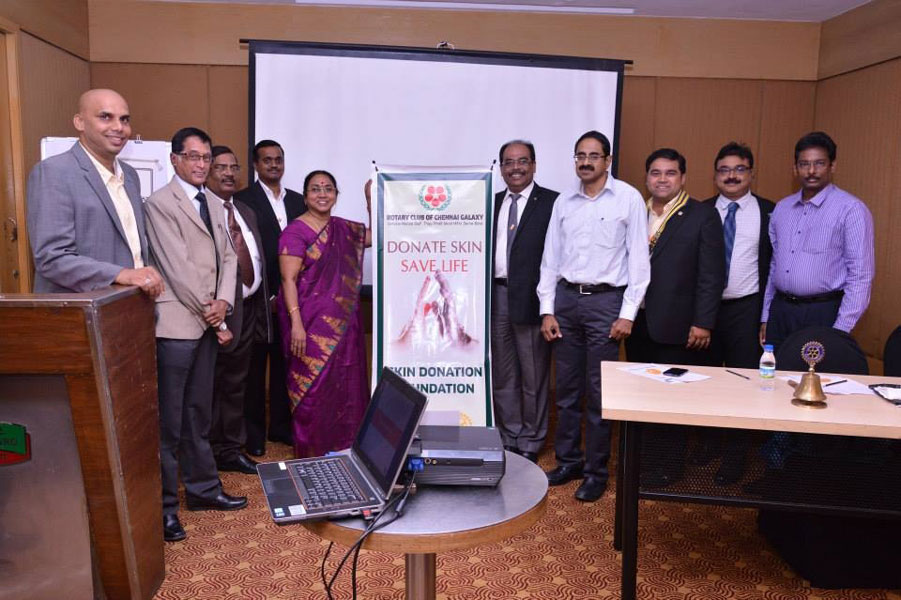How many people know that if they ever had the misfortune of getting a burn injury or any other skin problem requiring skin grafting, their own thighs can provide as much as 18 percent of the total skin that a human body has?

Add to this the two arms, and the burns specialist who is treating you will not have to look further for skin to save your life and treat your injuries.
But the problem arises when limbs are burnt; and the plastic surgeon can be at a loss. In such cases the presence of a skin bank in your city can help. Mumbai and Pune have skin banks supported by Rotary Club of Mumbai North (RI District 3140) and Rotary Club of Khadki (RI District 3131) respectively, Chennai too is going to get one, thanks to the initiative of the Rotary Club of Madras Galaxy, RI District 3230.
A young Rotary club in two ways, it was set up 11 years ago and the average age of its 37 members is 40 years. “We are going to sign an MoU with the Government of Tamil Nadu to set up a skin bank, most probably in the Government Stanley Hospital,” says Club President Nikhil Singhi. For guidance on this project they have the Mumbai club as well the Euro Skin Bank in Netherlands. Over the next 18 months the club plans to raise about ₹1.5 crore for this project.
Heading it on the medical side is Dr. K. Sridhar, a plastic surgeon with 38 years of experience. Now Senior Vice President of the SRM group, Chennai, the surgeons clarifies that contrary to popular perception, including in the medical community, aesthetic procedures and cosmetic surgery constitute only 10–15 percent of plastic surgery. The remaining is reconstructive and corrective surgery for congenital disorders such as cleft lip, burns due to acid attacks or electrical burns, face, jaw and hand injuries, reconstructing defect and deformity due to cancer or leprosy and restoring finger joints affected by arthritis or a congenital defect. Only then comes aesthetic surgery.
Skin grafting
When a patient comes with 50 percent burn injury — this is the skin surface and not to be confused with the degree of burn such as second or third degree which is related to the depth to which the skin is burnt — his/her own skin removed from the thighs and even arms is first used. But if this is not sufficient then the skin stored in a skin bank can be used to cover the burnt area. “Uncovered area causes infection and hence death,” says Dr. Sridhar. It is like borrowing somebody else’s skin for a short while, he adds.
But this will remain without decay and rejection for only two weeks. After this, it should be removed, and if a skin bank is available, the area should be covered with another donor’s skin. Using skin from the same donor will hasten rejection.
“So a skin bank helps you tide over the crisis of a major or over 50–60 percent burns. If your heart is functioning at 50 percent you can survive without any problem; same with the liver or just one kidney functioning. But nobody can survive with only 50 percent of their skin,” says Dr. Sridhar.
A skin bank is also vital when children suffer over 50 percent burns as their skin surface is limited. An interesting nugget: if a child is burnt and the mother donates her skin, the chance of rejection is less and recovery is faster.
Skin donation
While skin can be taken from a dead person — up to six hours after the heart stops beating — even a living person can donate his/her skin. And most often, mothers do so for their children. Skin can be removed from a live donor under general or spinal anaesthesia, and will grow back within two to three weeks, says the surgeon.
Apart from donating the money required to set up three collection centres and later the skin bank, Rotarians will work to spread awareness on the need for skin donation. Dr. Sridhar says more medical research and work is required to culture the victim’s own skin, to rule out rejection. “Also the skin from a uni-ovular twin — those born from a single placenta — will not get rejected, but of course these are very rare,” he adds.
Quick facts:
- Skin can be donated within six hours of death.
- Skin can be stored in a normal fridge for 2–3 weeks; in a skin bank for 9–12 months.
- Anybody over 18 can donate skin; wrinkled skin doesn’t matter.
- Mother-to-child live skin donation is possible and effective.
- A person’s own skin can be cultured.
- Pour cold water over burnt area immediately.
- Take care of your skin by moisturising, sun screen lotion, and protection from pollution.





